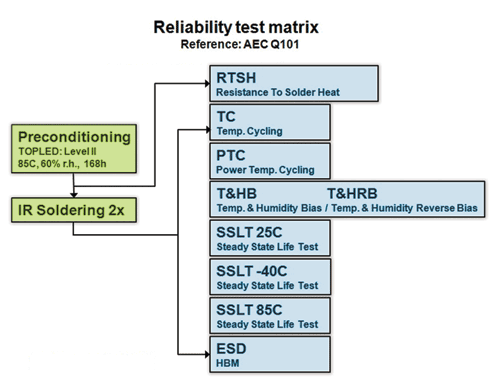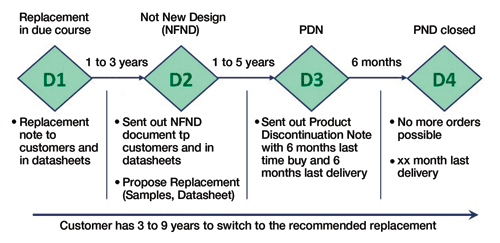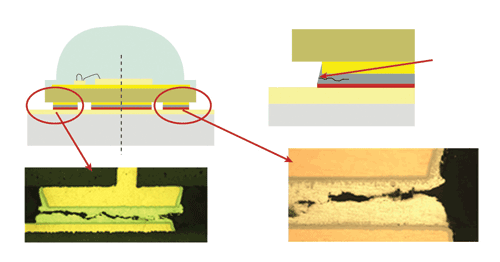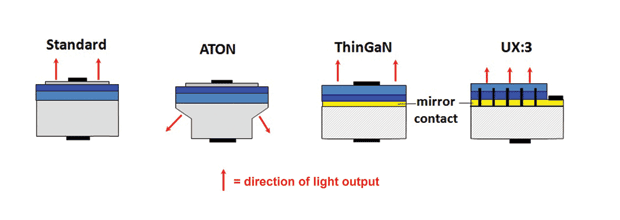LCD and projection displays for automotive applications impose unique considerations in evaluating LED performance, technology
BY DAVID S. ROUSSEAU
Product Marketing Manager, Visible LEDs
OSRAM Opto Semiconductors
www.osram-os.com
Automotive designers today have the benefit of being able to leverage the rapid growth in LCD TVs, LED-based projectors, automotive headlamps, and the rapidly growing LED general lighting market. However, there are key considerations in evaluating LED product performance and technology unique to automotive LCD and projection display applications. These include qualification, robustness, and life-cycle management. Additionally, the choice of various LED package types and materials, as well as chip and conversion technologies is influenced by the specific requirements for automotive.
Robustness and qualification
One of the easiest automotive criteria to assess is the validation requirements. In North America, the most common validation benchmark is AEC Q101, but this may not be sufficient to ensure that the LED meets the application requirements, as this spec is written around a generic semiconductor test requirement. Also, in some cases, specific tests were designed for general semiconductors and don’t apply specifically to LEDs.
Adoption of LEDs in certain automotive interior lighting applications is approaching 70% to 80%. Throughout this evolution, LED manufacturers have had to overcome some very tough reliability issues such as:
• Lumen degradation behavior
• Corrosive gas stability
• Electrical overstress
• Electrical static discharge
• Thermal shock
• Color degradation with humidity
Due to the additional reliability demands of LED technology in automotive applications (that is, life of vehicle performance), the AEC Q101 test matrix is not sufficient to deliver the customer’s expectations for high-reliability illumination. The design engineer needs to go beyond AEC Q101 and explore the inherent system failure modes and mechanisms in order to meet customer expectations.
Even if an LED supplier indicates that they meet AEC Q101, test selection is subject to interpretation and may vary from supplier to supplier (see Fig. 1 ). The selection of these tests can even vary for the same LED supplier, depending on such factors as whether the bond wire is exposed (as in non-cast or non-molded parts).

Fig. 1: Not all vendors use the same AEC Q101 tests for LEDs. Above are some of the relevant ones used by OSRAM.
In an effort to rectify these inconsistencies, ongoing work with international standards institutes is continuously aiming to develop new standards, such as IEC 68010-3, which, unlike the AEC Q101, would apply only to LEDs, and would cover testing for automotive applications, product change management, and report formats. The SAE (Society of Automotive Engineers) (SAE) will review this specification once it is finalized.
As LCD vehicle displays have a very high “on” time during vehicle operation, the LED infant mortality and wear-out failures need to be designed to meet the LCD’s Mission Profile. Using only the requirements of AEC Q101, test conditions are not likely to satisfy all of the reliability factors necessary to meet the specified LCD reliability Mission Profile. To meet the acceptable market PPM levels, LED testing needs to go beyond the application test conditions, and test to failure.
A display engineer needs to consider additional LED accelerated stress factors to understand the critical characteristics. A robust methodology that tests LEDs at operating conditions beyond AEC Q101 limits is needed to understand the phases of material, design, process and qualification stress factors.
Only with a comprehensive understanding of LED performance needs in the LCD application can the automotive reliability requirements be satisfied.
Life-cycle management
After qualification criteria, the next major evaluation is life-cycle management. The life cycle is defined as a 3-year design/validation phase, 3 to 5 years of actual production and, per OEM request, 10 to 15 years of service parts. Thus components need to be available for almost 20 years much longer than is required for consumer, general lighting, and other markets. So LEDs for such markets may not be the best choice for automotive uses.
A formal JEDEC standard PDN (product discontinuation notification) process, developed by OSRAM after many years working with the automotive industry, satisfies the longer automotive product life cycles that are required (see Fig. 2 ). The goal was to provide automotive customers with a 3 to 9-year advance notice for any product discontinuation.

Fig. 2: Because automotive applications are long lived, OSRAM developed and uses the JEDEC standard PDN process for LEDs seen here.
With this approach, if the LED shelf life of 2 years is factored in with the 3 to 9-year product discontinuation process, then the Tier I has a 5 to 11-year window before a change has to be implemented. While this process does not guarantee that every product will meet the 20 year criteria, it does provide a higher level of assurance that, if the 20-year life cycle is not achieved, designers have sufficient time to implement alternate black-box solutions.
At the root of the life-cycle dilemma is an ongoing battle to balance the need for a long life cycle with the need to maintain competitive prices. With a 5 to 11-year buffer, the Tier I suppliers have the time to integrate changes at a more convenient time, such as a model-year change-over when components systems may have to be revalidated.
Packaging
In selecting LED packaging materials, there are many engineering and design trade-offs that may not be immediately obvious to the LCD designer. For example, lumen depreciation and the degradation phases of ceramic and pre-mold LEDs are very different when an LED is operated in a continuous steady-state life test condition. Pre-molded LEDs use a plastic package that provides higher reliability, but may degrade due to plastic aging or darkening in the early hours of operation.
There are four phases of degradation in a pre-molded LED: initial chip aging, package aging (reflector darkening), stable phase, and, finally, long-term chip degradation. On the other hand, ceramic packages have a different degradation model, due to the optical design of the package and the ceramic material’s resistance to aging mechanisms. This model has only three phases; packaging aging does not apply.
Another consideration is how the package will handle thermal shock. To deliver the desired system reliability, material selection needs to balance the coefficient of thermal expansion (CTE) of all integral components (i.e., solder, PCB, ceramic, plastics, glues, etc.). Designing for life-of-vehicle applications with the extreme thermal shock requirements of −40ºC to 85ºC using ROHS-compliant solder can be a system-level challenge to reliability (see Fig. 3 ). The CTE influence was demonstrated in a comparison study of ceramic versus molded packages, with interesting trade-offs in the systems design.

Fig. 3: Images of a ceramic LED show the effect of solder joint cracking after 1,000 thermal shock cycles.
Accelerated robustness testing of ceramic and lead-frame-based packages of equivalent size and performance was done using an extreme thermal cycle of −40º to 125ºC. After the parts were tested, the sheer force was measured on the parts and failure rate noted. The data revealed that both parts performed very well; however, at 1,000 cycles the lead-frame-based part had superior shock resistance.
These are just a few examples of packaging trade-offs when selecting an LED for a high reliability LCD application.
Phosphor conversion
For LCD backlighting, LED phosphor materials have unique roles. A full color TFT display requires a full spectrum of red, green and blue, which is accomplished with a two-part phosphor system for a high quality display. Typical white LEDs designed for BLUs that use multiple phosphors to reach this color gamut have the following drawbacks:
Efficiency must be traded-off for color gamut
Intensity and color stability can be affected by operating temperature and humidity
Further, selecting the right pump wavelength is critical: the LED’s blue wavelength and the thin-film-transistor (TFT) display’s blue color filters can interact in such a way as to shift the color of the display. So for optimal color performance, the chip wavelength must be matched properly to the characteristics of the color filter.
Until the recent commercialization of ceramic layer conversion with green ceramic in pico and pocket projection, thermal quenching of the phosphor has been an issue and had to be addressed by reducing drive current on the LED in demanding systems such as those used in automotive applications. Today, there is a newly developed portfolio of C2 (ceramic conversion) technology that enhances the efficiency of classic white and color LEDs.
In the case of projection systems, the LED light source requires a red, blue and green LED. Since the human eye response is most sensitive at 555 nm, green light emission contributes about 75% of the total white screen lumens. Demand for brighter projection systems has driven the need for brighter green LEDs. An effective way of producing brighter greens is to utilize phosphor conversion. One issue with phosphor converted green is that it generates a wide spectrum, unlike the narrow bandwidth of a saturated green LED. To overcome this, filters are used to narrow the phosphor-converted green bandwidth.
OSRAM recently released a top-emitting chip package with C2 technology that doubled green LED output and delivered 30% more lumens on the screen with a digital micromirror device (DMD). This significantly improves performance for pico and pocket projector systems, and could also impact future automotive heads-up displays (HUDs) and other free-form projection applications.
Chip technology
One of the driving factors in developing new chips is to get to a high lumen per dollar ratio. To accomplish this, there are several chip development strategies: increase the die brightness; reduce effect of droop; and reduce the chip cost. Chip technology has evolved from the GaN/InGaN on SiC substrates to Sapphire and ThinFilm technology (see Fig. 4 ).

Fig. 4: Chip technologies comparison
One example of a chip based on ThinFilm technology is the OSRAM UX:3. The chip also incorporates new internal current-spreading pillars to generate a more uniform current density, improving the uniformity of surface light emission. The pillars also provide a better thermal path, which lets the chip run more efficiently.
Another strategy being employed in chip development is the ongoing effort to drive costs out of the LED by producing gallium nitride LED chips on a silicon substrate instead of a much more expensive sapphire one. ■
Advertisement
Learn more about Osram Opto Semiconductors





